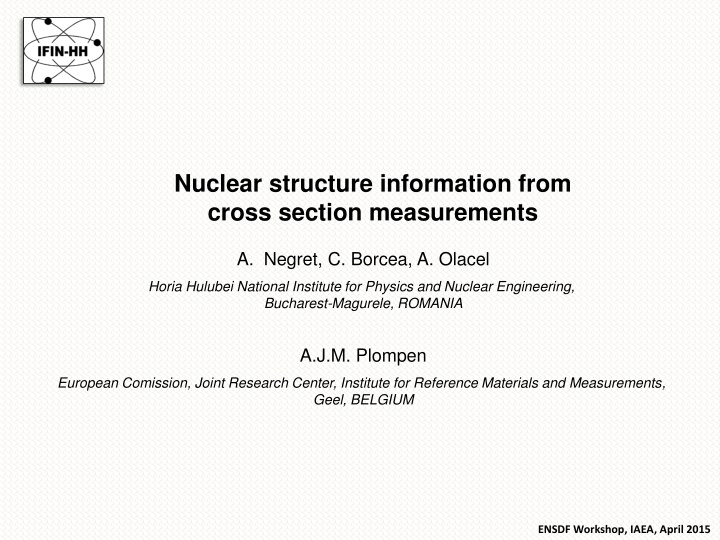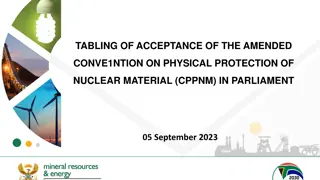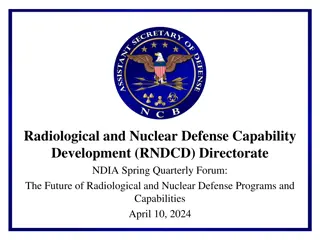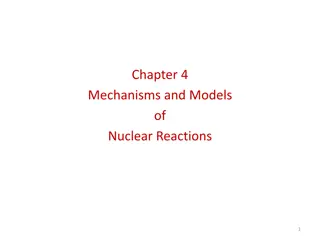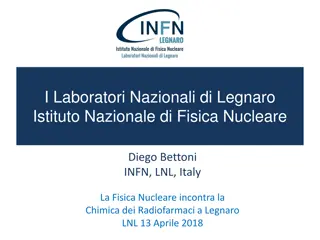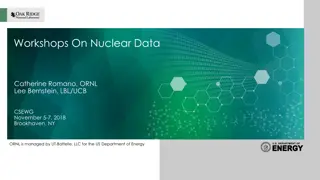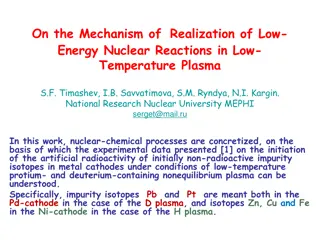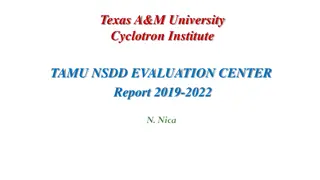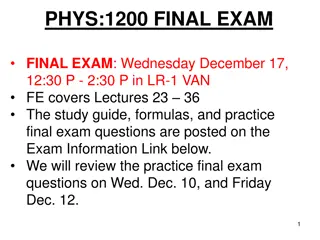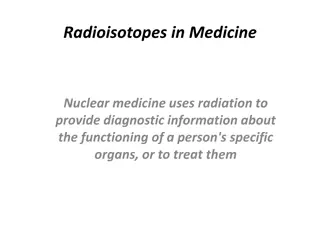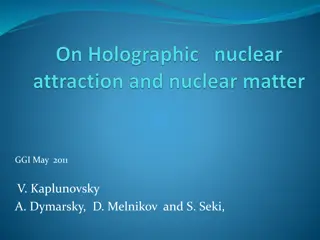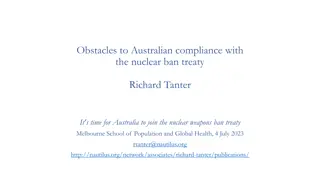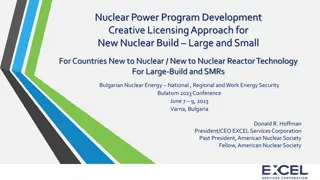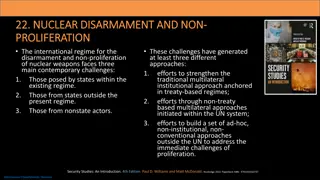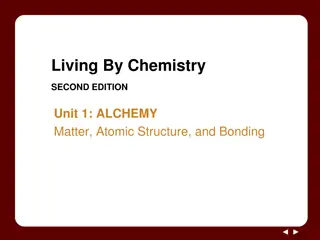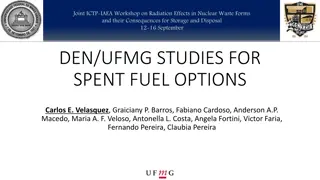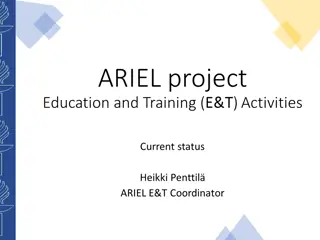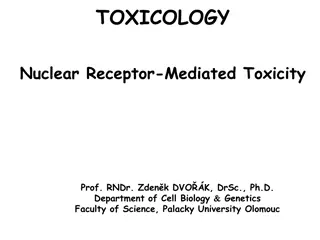Nuclear Structure Information from Cross Section Measurements
This study presents findings on nuclear structure information obtained from cross section measurements conducted by A. Negret, C. Borcea, and A. Olacel at Horia Hulubei National Institute for Physics and Nuclear Engineering in Romania. The measurements include neutron inelastic cross section studies using GAINS at EC-JRC-IRMM, showcasing the analysis, examples, and conclusions derived from the data. The use of GELINA as a neutron source and the implementation of the TOF technique with the Gamma Array for Inelastic Neutron Scattering (GAINS) are detailed, along with insights into data analysis and gamma spectroscopy for determining cross sections.
Download Presentation

Please find below an Image/Link to download the presentation.
The content on the website is provided AS IS for your information and personal use only. It may not be sold, licensed, or shared on other websites without obtaining consent from the author.If you encounter any issues during the download, it is possible that the publisher has removed the file from their server.
You are allowed to download the files provided on this website for personal or commercial use, subject to the condition that they are used lawfully. All files are the property of their respective owners.
The content on the website is provided AS IS for your information and personal use only. It may not be sold, licensed, or shared on other websites without obtaining consent from the author.
E N D
Presentation Transcript
Nuclear structure information from cross section measurements A. Negret, C. Borcea, A. Olacel Horia Hulubei National Institute for Physics and Nuclear Engineering, Bucharest-Magurele, ROMANIA A.J.M. Plompen European Comission, Joint Research Center, Institute for Reference Materials and Measurements, Geel, BELGIUM ENSDF Workshop, IAEA, April 2015
A. Negret Nuclear structure information from cross section measurements Summary 1. Neutron inelastic cross section measurements using GAINS at EC-JRC-IRMM 2. What can we learn? 3. Examples 4. Conclusions ENSDF Workshop, IAEA, April 2015
A. Negret Nuclear structure information from cross section measurements Cross section measurements with GAINS 1. Neutron inelastic cross section measurements using GAINS at EC-JRC-IRMM 2. What can we learn? 3. Examples 4. Conclusions ENSDF Workshop, IAEA, April 2015
A. Negret Nuclear structure information from cross section measurements GELINA (Geel Linear Accelerator): the white neutron source Neutron source: GELINA (white flux 100 keV 20 MeV), operated by EC-JRC-IRMM, Geel, Belgium TOF technique (200 m flight path): Amplitude gamma energy Time neutron energy ENSDF Workshop, IAEA, April 2015
A. Negret Nuclear structure information from cross section measurements GAINS: Gamma Array for Inelastic Neutron Scattering Array of 12 HPGe detectors ( =100%) used for highly precise neutron inelastic cross section measurements. TOF technique (200 m flight path): Amplitude gamma energy Time neutron energy Digitizer-based acquisition (Acqiris DC440, 420 MS/s, 12 bits) Beam monitoring: 235U Fission chamber ENSDF Workshop, IAEA, April 2015
A. Negret Nuclear structure information from cross section measurements GAINS: Basic Idea of data analysis Amplitude gamma energy Time neutron energy ENSDF Workshop, IAEA, April 2015
A. Negret Nuclear structure information from cross section measurements GAINS: The gamma spectroscopy used to determine X(n,n )X cross sections 12 x HPGE yield FC yield HPGe Efficiency: Monte-Carlo simulation FC Efficiency Gamma Production cross sections ENSDF: level scheme Total inelastic cross section Level cross sections ENSDF Workshop, IAEA, April 2015
A. Negret Nuclear structure information from cross section measurements Experim. result: production cross sections (= excitation functions) 28Si(n,n )28Si ENSDF Workshop, IAEA, April 2015
A. Negret Nuclear structure information from cross section measurements Experim. result: level cross sections, total inelastic cross section 28Si(n,n )28Si ENSDF Workshop, IAEA, April 2015
A. Negret Nuclear structure information from cross section measurements What can we learn 1. Neutron inelastic cross section measurements using GAINS at EC-JRC-IRMM 2. What can we learn 3. Examples 4. Conclusions ENSDF Workshop, IAEA, April 2015
A. Negret Nuclear structure information from cross section measurements What can we learn: assignment of s to levels 28Si(n,n )28Si ENSDF Workshop, IAEA, April 2015
A. Negret Nuclear structure information from cross section measurements What can we learn: branching ratios If two gammas decay from the same level: - Their gamma production cross section has the same shape - The ratios of gamma production cross sections for each point is the branching ratio. So we actually can determine the branching ratio for each neutron energy (about 2000 values). 28Si(n,n )28Si ENSDF Workshop, IAEA, April 2015
A. Negret Nuclear structure information from cross section measurements Examples 1. Neutron inelastic cross section measurements using GAINS at EC-JRC-IRMM 2. What can we learn 3. Examples 4. Conclusions ENSDF Workshop, IAEA, April 2015
A. Negret Nuclear structure information from cross section measurements The 3-, 3076.2 keV level in 56Fe We did 56Fe(n,n )56Fe and were able to build level cross sections for all low lying levels Except this one: ENSDF Workshop, IAEA, April 2015
A. Negret Nuclear structure information from cross section measurements The 3-, 3076.2 keV level in 56Fe E =991 keV ENSDF Workshop, IAEA, April 2015
A. Negret Nuclear structure information from cross section measurements Branching ratios in 206Pb s coming from the same level have similar shapes (and of course the same threshold). The proportionality factor is the branching ratio. In 206Pb(n,n )206Pb, for several levels, we saw more then one decaying . EL=1684.0 keV EL=2196.7 keV ENSDF Workshop, IAEA, April 2015
A. Negret Nuclear structure information from cross section measurements Branching ratios in 206Pb In 206Pb(n,n )206Pb, for several levels, we saw more then one decaying : 37.5(7) 100 100 78.9(12) 58.4(19) 24.6(18) 100 81.6(14) 100 36.9(39) 100 100.3(25) ENSDF Workshop, IAEA, April 2015
A. Negret Nuclear structure information from cross section measurements The 2041-keV transition in 206Pb Possible source of neutron-induced background for neutrinoless double beta decay experiments [Q (76Ge)=2039.06 keV] 206Pb(n,n )206Pb; E = 2041 keV 40 15 Integration Background Background Counts / keV 35 (mb) 10 30 25 5 20 0 0 2 4 6 8 10 12 14 16 En(MeV) 2 2.02 2.04 2.06 2.08 2.1 E (MeV) Eth 3 MeV ENSDF Workshop, IAEA, April 2015
A. Negret Nuclear structure information from cross section measurements Conclusions 1. Neutron inelastic cross section measurements using GAINS at EC-JRC-IRMM 2. What can we learn 3. Examples 4. Conclusions ENSDF Workshop, IAEA, April 2015
A. Negret Nuclear structure information from cross section measurements Conclusions Neutron inelastic cross section data produced at GELINA could contain nuclear structure information valuable for ENSDF: - level and gamma transition sequence - branching ratio Other pieces of information like E values are actually ignored due to the fact that the primary purpose of this experimental effort is directed towards production of precise reaction. ENSDF Workshop, IAEA, April 2015
